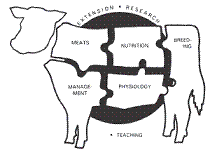Animal Science, Department of

Nebraska Beef Cattle Reports
Date of this Version
2023
Citation
2023 Nebraska Beef Cattle Report
UNL Beef, Institute of Agriculture and Natural Resources, University of Nebraska-Lincoln
Abstract
The weighting of traits in a selection index depends on varying circumstances that can difer among beef producers (e.g. economic factors, breeding systems). The determination of planning horizon is an additional variable that can differ among producers that represents the impact of genetic selection decisions over a gradient of time. A web-based economic index construction platform (iGENDEC) was used in the current study to investigate the implications of planning horizon on relative emphasis values of traits within the breeding goal and potential differences in sire selection decisions. General-purpose indexes were created for three breeding systems under six different planning horizons (2-50 yrs). Relative emphasis for weight (weaning or hot carcass) at point for sale decreased while stayability increased as length of the planning horizon increased. The ranking of selection candidates varied as planning horizon and the point of sale changed. The results are indicative of the importance for determining the correct planning horizon when developing selection indexes.
Included in
Large or Food Animal and Equine Medicine Commons, Meat Science Commons, Veterinary Preventive Medicine, Epidemiology, and Public Health Commons

